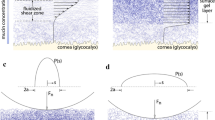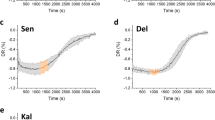Abstract
The most distal surfaces of lubricious high water-content aqueous gels may have decreasing concentrations and gradients of macromolecular chains on the surface that emanate outward into the environment. This superficial zone of extended polymer chains has a water-content that approaches 100% over the final few hundred nanometers, and the superficial modulus is the elastic modulus of this superficial surface. Micro-rheology using high-speed microscopy with fluorescent nanospheres enabled measurements of both the storage modulus G′ and the loss modulus G″ over a frequency range of 0.4 1/s–50 1/s. 100 µm-thick control samples of polyacrylamide gels with equilibrium water-content of 97.9%, 98.4%, and 98.9% had measured storage moduli of 70.3 ± 26.9 Pa, 53.3 ± 22.4 Pa, and 38.8 ±14 Pa, respectively. Master curves based on meta-data analysis from published measurements of mesh-size, water-content, and elastic modulus were created and used to relate rheological measurements of the superficial modulus to water-content and mesh-size. This interfacial microrheological measurement method was further used to quantify the superficial modulus and water-content of two commercial contact lens materials that have water-gradient gels on their surfaces: delefilcon A (E = 48 ± 11 Pa, > 99.6% water) and lehfilcon A (E = 10 ± 8 Pa, > 99.7% water). The micro-rheology method on Gemini gel interfaces facilitates measurements of the most distal superficial zone of aqueous gels and the quantification of the superficial modulus and water-content of these surfaces.
Graphic Abstract






Similar content being viewed by others
References
Bonyadi, S.Z., Hasan, M.M., Kim, J., Mahmood, S., Schulze, K.D., Dunn, A.C.: Review: friction and lubrication with high water content crosslinked hydrogels. Tribol. Lett. 68, 119 (2020). https://doi.org/10.1007/s11249-020-01352-3
Pitenis, A.A., Urueña, J.M., Nixon, R.M., Bhattacharjee, T., Krick, B.A., Dunn, A.C., Angelini, T.E., Sawyer, W.G.: Lubricity from entangled polymer networks on hydrogels. J. Tribol. 138, 042102 (2016). https://doi.org/10.1115/1.4032889
Pitenis, A.A., Sawyer, W.G.: Lubricity of high water content aqueous Gels. Tribol. Lett. 66, 113 (2018). https://doi.org/10.1007/s11249-018-1063-5
Pitenis, A.A., Urueña, J.M., Cooper, A.C., Angelini, T.E., Sawyer, W.G.: Superlubricity in Gemini hydrogels. J. Tribol. 138, 042103 (2016). https://doi.org/10.1115/1.4032890
Urueña, J.M., Pitenis, A.A., Nixon, R.M., Schulze, K.D., Angelini, T.E., Sawyer, W.G.: Mesh size control of polymer fluctuation lubrication in Gemini hydrogels. Biotribology 1–2, 24–29 (2015). https://doi.org/10.1016/j.biotri.2015.03.001
Meier, Y.A., Zhang, K., Spencer, N.D., Simic, R.: Linking friction and surface properties of hydrogels molded against materials of different surface energies. Langmuir 35, 15805–15812 (2019). https://doi.org/10.1021/acs.langmuir.9b01636
Dunn, A.C., Urueña, J.M., Huo, Y., Perry, S.S., Angelini, T.E., Sawyer, W.G.: Lubricity of surface hydrogel layers. Tribol. Lett. 49, 371–378 (2013). https://doi.org/10.1007/s11249-012-0076-8
Kii, A., Xu, J., Gong, J.P., Osada, Y., Zhang, X.: Heterogeneous polymerization of hydrogels on hydrophobic substrate. J. Phys. Chem. B 105, 4565–4571 (2001). https://doi.org/10.1021/jp003242u
Simič, R., Spencer, N.D.: Controlling the friction of gels by regulating interfacial oxygen during polymerization. Tribol. Lett. 69, 86 (2021). https://doi.org/10.1007/s11249-021-01459-1
Hart, S.M., McGhee, E.O., Urueña, J.M., Levings, P.P., Eikenberry, S.S., Schaller, M.A., Pitenis, A.A., Sawyer, W.G.: Surface gel layers reduce shear stress and damage of corneal epithelial cells. Tribol. Lett. 68, 106 (2020). https://doi.org/10.1007/s11249-020-01344-3
Linden, S.K., Sutton, P., Karlsson, N.G., Korolik, V., McGuckin, M.A.: Mucins in the mucosal barrier to infection. Mucosal Immunol. 1, 183–197 (2008). https://doi.org/10.1038/mi.2008.5
Zhang, K., Simic, R., Spencer, N.D.: Imparting ultralow lubricity to double-network hydrogels by surface-initiated controlled radical polymerization under ambient conditions. Biotribology 26, 100161 (2021). https://doi.org/10.1016/j.biotri.2021.100161
Seror, J., Zhu, L., Goldberg, R., Day, A.J., Klein, J.: Supramolecular synergy in the boundary lubrication of synovial joints. Nat. Commun. 6, 6497 (2015). https://doi.org/10.1038/ncomms7497
Ma, L., Gaisinskaya-Kipnis, A., Kampf, N., Klein, J.: Origins of hydration lubrication. Nat. Commun. 6, 1–6 (2015). https://doi.org/10.1038/ncomms7060
Lin, W., Klein, J.: Recent progress in cartilage lubrication. Adv. Mater. 33, 2005513 (2021). https://doi.org/10.1002/adma.202005513
Moore, A.C., Burris, D.L.: Tribological rehydration of cartilage and its potential role in preserving joint health. Osteoarthr. Cartil. 25, 99–107 (2017). https://doi.org/10.1016/j.joca.2016.09.018
Shoaib, T., Espinosa-Marzal, R.M.: Insight into the viscous and adhesive contributions to hydrogel friction. Tribol. Lett. 66, 96 (2018). https://doi.org/10.1007/s11249-018-1045-7
Li, A., Ramakrishna, S.N., Kooij, E.S., Espinosa-Marzal, R.M., Spencer, N.D.: Poly(acrylamide) films at the solvent-induced glass transition: adhesion, tribology, and the influence of crosslinking. Soft Matter 8, 9092 (2012). https://doi.org/10.1039/c2sm26222c
Mason, T.G., Weitz, D.A.: Optical measurements of frequency-dependent linear viscoelastic moduli of complex fluids. Phys. Rev. Lett. 74, 1250–1253 (1995). https://doi.org/10.1103/PhysRevLett.74.1250
Schulze, K.D., Hart, S.M., Marshall, S.L., O’Bryan, C.S., Urueña, J.M., Pitenis, A.A., Sawyer, W.G., Angelini, T.E.: Polymer osmotic pressure in hydrogel contact mechanics. Biotribology 11, 3–7 (2017). https://doi.org/10.1016/j.biotri.2017.03.004
Mason, T.G.: Estimating the viscoelastic moduli of complex fluids using the generalized Stokes-Einstein equation. Rheol. Acta 39, 371–378 (2000). https://doi.org/10.1007/s003970000094
De Gennes, P.G.: Scaling Concepts in Polymer Physics. Cornell University Press, Ithaca (1979)
Gordon, M.: Scaling Concepts in Polymer Physics. Cornell University Press, Ithaca (1981)
Munoz-Pinto, D.J., Samavedi, S., Grigoryan, B., Hahn, M.S.: Impact of secondary reactive species on the apparent decoupling of poly(ethylene glycol) diacrylate hydrogel average mesh size and modulus. Polymer (Guildf). 77, 227–238 (2015). https://doi.org/10.1016/j.polymer.2015.09.032
Bhattacharyya, A., O’Bryan, C., Ni, Y., Morley, C.D., Taylor, C.R., Angelini, T.E.: Hydrogel compression and polymer osmotic pressure. Biotribology 22, 100125 (2020). https://doi.org/10.1016/j.biotri.2020.100125
Park, I.H., Johnson, C.S., Gabriel, D.A.: Probe diffusion in polyacrylamide gels as observed by means of holographic relaxation methods: search for a universal equation. Macromolecules 23, 1548–1553 (1990). https://doi.org/10.1021/ma00207a052
Wu, P.-J., Kabakova, I.V., Ruberti, J.W., Sherwood, J.M., Dunlop, I.E., Paterson, C., Török, P., Overby, D.R.: Water content, not stiffness, dominates Brillouin spectroscopy measurements in hydrated materials. Nat. Methods. 15, 561–562 (2018). https://doi.org/10.1038/s41592-018-0076-1
Horkay, F., Magda, J., Alcoutlabi, M., Atzet, S., Zarembinski, T.: Structural, mechanical and osmotic properties of injectable hyaluronan-based composite hydrogels. Polymer (Guildf). 51, 4424–4430 (2010). https://doi.org/10.1016/j.polymer.2010.06.027
Girardo, S., Träber, N., Wagner, K., Cojoc, G., Herold, C., Goswami, R., Schlüßler, R., Abuhattum, S., Taubenberger, A., Reichel, F., Mokbel, D., Herbig, M., Schürmann, M., Müller, P., Heida, T., Jacobi, A., Ulbricht, E., Thiele, J., Werner, C., Guck, J.: Standardized microgel beads as elastic cell mechanical probes. J. Mater. Chem. B 6, 6245–6261 (2018). https://doi.org/10.1039/C8TB01421C
Funding
The research leading to these results received funding from Alcon Laboratories. Author DTN is supported by a National Science Foundation Graduate Research Fellowship.
Author information
Authors and Affiliations
Corresponding author
Ethics declarations
Conflict of interest
The authors have no financial or proprietary interests in any material discussed in this article.
Additional information
Publisher's Note
Springer Nature remains neutral with regard to jurisdictional claims in published maps and institutional affiliations.
Rights and permissions
About this article
Cite this article
Pedro, D.I., Nguyen, D.T., Trachsel, L. et al. Superficial Modulus, Water-Content, and Mesh-Size at Hydrogel Surfaces. Tribol Lett 69, 160 (2021). https://doi.org/10.1007/s11249-021-01538-3
Received:
Accepted:
Published:
DOI: https://doi.org/10.1007/s11249-021-01538-3




